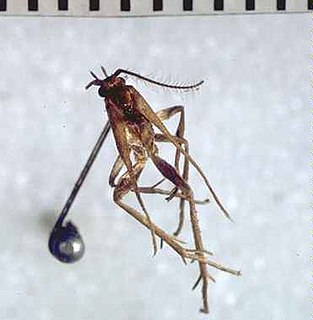
The Crambidae are the grass moth family of lepidopterans. They are variable in appearance, the nominal subfamily Crambinae taking up closely folded postures on grass stems where they are inconspicuous, while other subfamilies include brightly coloured and patterned insects which rest in wing-spread attitudes.
Mnesictena is a genus of snout moths in the subfamily Spilomelinae, where it is placed in the tribe Udeini. The genus was erected by the English entomologist Edward Meyrick in 1884. The currently known seven species are exclusively found on New Zealand and the associated Antipodes Islands and Chatham Islands.
Proterodesma is a genus of moths belonging to the family Tineidae. All the species in this genus are endemic to New Zealand.

Campbellana is a genus of moths of the Carposinidae family, containing only one species, Campbellana attenuata. This species is endemic to the Campbell Islands of New Zealand.

Planotortrix is a genus of moths belonging to the subfamily Tortricinae of the family Tortricidae.
Sorensenata is a genus of moths belonging to the subfamily Tortricinae of the family Tortricidae. It contains only one species, Sorensenata agilitata, Sorenson's agile moth, which is found in New Zealand, where it has been recorded from Campbell Island.

Dumbletonius unimaculata is a species of moth of the family Hepialidae. It is endemic to New Zealand. This species is host to the vegetable caterpillar fungus Ophiocordyceps robertsii.
Scoparia monochroma is a species of moth in the family Crambidae. It is endemic to New Zealand.

Eudonia albafascicula is a moth of the family Crambidae. It was described by John Salmon in 1956. It is endemic to New Zealand, and can be found on Antipodes Island.
Scoparia crepuscula is a species of moth in the family Crambidae. It is endemic to New Zealand.

Planotortrix flammea is a species of moth of the family Tortricidae. It is endemic to New Zealand.

Planotortrix notophaea, the blacklegged leafroller, is a species of moth in the family Tortricidae. It is endemic to New Zealand. It was also present near Sydney in Australia, but this population is thought to be extinct.

Hierodoris is a genus of moths in the family Oecophoridae. It was first described by Edward Meyrick in 1912. This genus is only known from New Zealand. In 1988 the genus Taoscelis was synonymised with Hierodoris. In 2005 the genus Coridomorpha was synonymised with Hierodoris.

Mnesictena antipodea is a moth in the family Crambidae. It was described by John T. Salmon in 1956. This species is endemic to New Zealand, where it has been recorded from the Antipodes Islands.

Proterodesma turbotti is a species of moth in the family Tineidae. It was described by John Salmon & John David Bradley in 1956. This species is endemic to New Zealand.

Hierodoris bilineata is a species of moth in the family Oecophoridae. It is endemic to New Zealand. This species is classified as "At Risk, Naturally Uncommon" by the Department of Conservation. It is possible that this species gives birth to live young rather than lay eggs as is the norm.

Lysiphragma argentaria is a species of moth in the family Tineidae. It is endemic to New Zealand. It is classified as "At Risk, Naturally Uncommon" by the Department of Conservation.

Asaphodes cinnabari is a species of moth in the family Geometridae. This species is endemic to New Zealand and can be found in Otago and Southland where it lives in alpine swampy habitat. Adults of this species are on the wing in November.

Ichneutica erebia is a moth of the family Noctuidae. This species is endemic to New Zealand and is found on Campbell Island and the Auckland Islands. Adults of this species are on the wing from August to January. The adults are variable in appearance but can be distinguished from similar species by the patters or lack thereof on their forewings. The larvae of I. erebia are polyphagous and hosts include Pleurophyllum criniferum, species within the genera Stilbocarpa and Carex, as well as Chionochloa antarctica', Urtica australis and Raukaua simplex.

Tinearupa sorenseni is a moth of the family Oecophoridae first described by John Salmon and John David Bradley in 1956. It is endemic to New Zealand.














